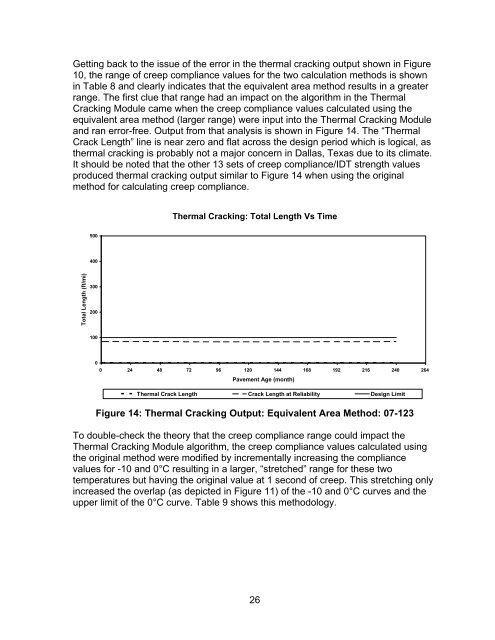Determination of Creep Compliance and Tensile Strength of Hot-Mix ...
Determination of Creep Compliance and Tensile Strength of Hot-Mix ...
Determination of Creep Compliance and Tensile Strength of Hot-Mix ...
- No tags were found...
You also want an ePaper? Increase the reach of your titles
YUMPU automatically turns print PDFs into web optimized ePapers that Google loves.
Getting back to the issue <strong>of</strong> the error in the thermal cracking output shown in Figure10, the range <strong>of</strong> creep compliance values for the two calculation methods is shownin Table 8 <strong>and</strong> clearly indicates that the equivalent area method results in a greaterrange. The first clue that range had an impact on the algorithm in the ThermalCracking Module came when the creep compliance values calculated using theequivalent area method (larger range) were input into the Thermal Cracking Module<strong>and</strong> ran error-free. Output from that analysis is shown in Figure 14. The “ThermalCrack Length” line is near zero <strong>and</strong> flat across the design period which is logical, asthermal cracking is probably not a major concern in Dallas, Texas due to its climate.It should be noted that the other 13 sets <strong>of</strong> creep compliance/IDT strength valuesproduced thermal cracking output similar to Figure 14 when using the originalmethod for calculating creep compliance.Thermal Cracking: Total Length Vs Time500400Total Length (ft/mi)30020010000 24 48 72 96 120 144 168 192 216 240 264Pavement Age (month)Thermal Crack Length Crack Length at Reliability Design LimitFigure 14: Thermal Cracking Output: Equivalent Area Method: 07-123To double-check the theory that the creep compliance range could impact theThermal Cracking Module algorithm, the creep compliance values calculated usingthe original method were modified by incrementally increasing the compliancevalues for -10 <strong>and</strong> 0°C resulting in a larger, “stretched” range for these twotemperatures but having the original value at 1 second <strong>of</strong> creep. This stretching onlyincreased the overlap (as depicted in Figure 11) <strong>of</strong> the -10 <strong>and</strong> 0°C curves <strong>and</strong> theupper limit <strong>of</strong> the 0°C curve. Table 9 shows this methodology.26
















